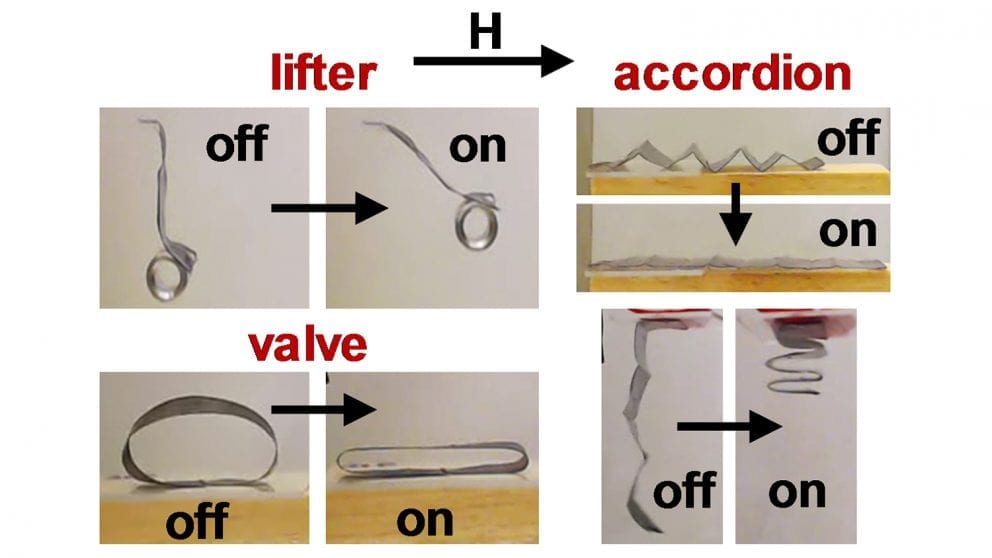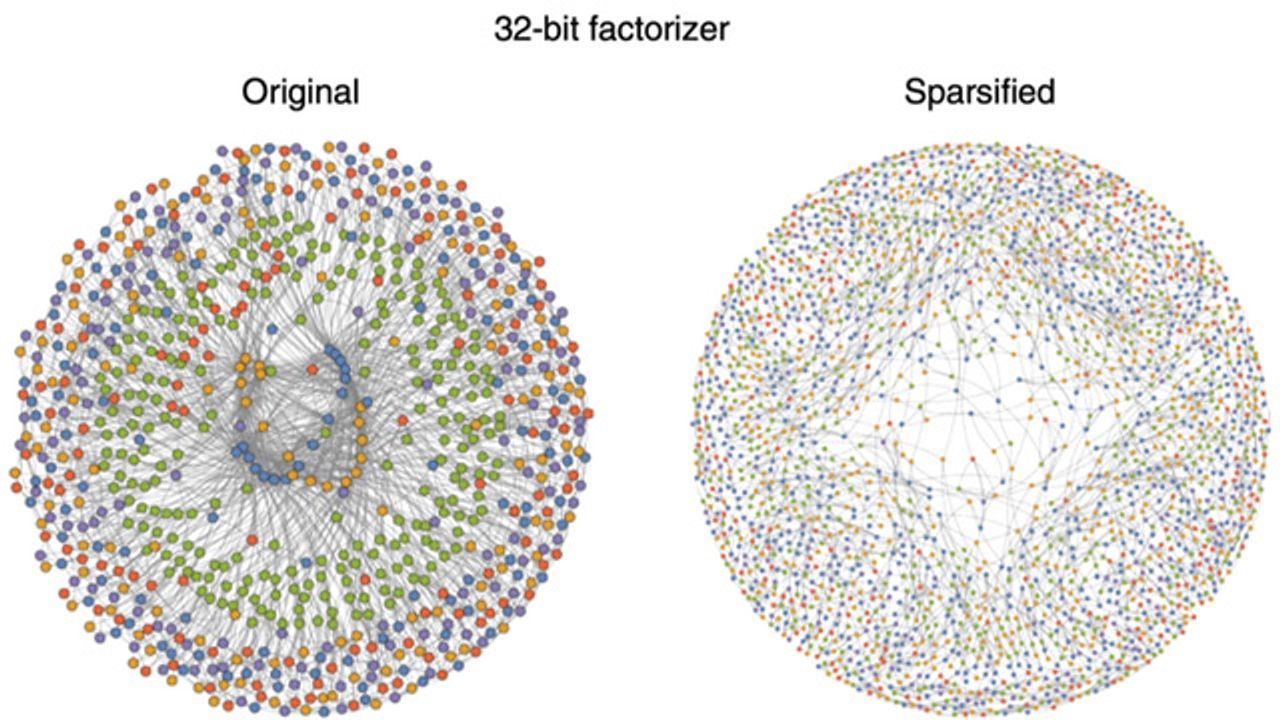
A 3D-printed “meta-bot” developed by UCLA engineers is capable of propulsion, movement, sensing and decision-making. It is manufactured all at once by a new type of 3D printing process for engineered active materials with multiple functions (also known as metamaterials).
A team of UCLA engineers and their colleagues have developed a new design strategy and 3D printing technique to build robots in one single step.
A study that outlined the advance, along with the construction and demonstration of an assortment of tiny robots that walk, maneuver and jump, was published in Science today.
The breakthrough enabled the entire mechanical and electronic systems needed to operate a robot to be manufactured all at once by a new type of 3D printing process for engineered active materials with multiple functions (also known as metamaterials). Once 3D printed, a “meta-bot” will be capable of propulsion, movement, sensing and decision-making.
The printed metamaterials consist of an internal network of sensory, moving and structural elements and can move by themselves following programmed commands. With the internal network of moving and sensing already in place, the only external component needed is a small battery to power the robot.
“We envision that this design and printing methodology of smart robotic materials will help realize a class of autonomous materials that could replace the current complex assembly process for making a robot,” said Xiaoyu (Rayne) Zheng.
“We envision that this design and printing methodology of smart robotic materials will help realize a class of autonomous materials that could replace the current complex assembly process for making a robot,” said the study’s principal investigator Xiaoyu (Rayne) Zheng, an associate professor of civil and environmental engineering, and of mechanical and aerospace engineering at the UCLA Samueli School of Engineering. “With complex motions, multiple modes of sensing and programmable decision-making abilities all tightly integrated, it’s similar to a biological system with the nerves, bones and tendons working in tandem to execute controlled motions.”
The team demonstrated the integration with an on-board battery and controller for the fully autonomous operation of the 3D printed robots — each at the size of a finger nail. According to Zheng, who is also a member of the California NanoSystems Institute at UCLA, the methodology could lead to new designs for biomedical robots, such as self-steering endoscopes or tiny swimming robots, which can emit ultrasounds and navigate themselves near blood vessels to deliver drug doses at specific target sites inside the body.
These “meta-bots” can also explore hazardous environments. In a collapsed building, for example, a swarm of such tiny robots armed with integrated sensing parts could quickly access confined spaces, assess threat levels and help rescue efforts by finding people trapped in the rubble.
Rayne Research Group/UCLA
UCLA-developed “meta-bots” demonstrate their flexibility and abilities to navigate tough terrain and avoid obstacles
Most robots, no matter their size, are typically built in a series of complex manufacturing steps that integrate the limbs, electronic and active components. The process results in heavier weights, bulkier volumes and reduced force output compared to robots that could be built using this new method.
The key in the UCLA-led, all-in-one method is the design and printing of piezoelectric metamaterials — a class of intricate lattice materials that can change shape and move in response to an electric field or create electrical charge as a result of physical forces.
The use of active materials that can translate electricity to motions is not new. However, these materials generally have limits in their range of motion and distance of travel. They also need to be connected to gearbox-like transmission systems in order to achieve desired motions.
By contrast, the UCLA-developed robotic materials — each the size of a penny — are composed of intricate piezoelectric and structural elements that are designed to bend, flex, twist, rotate, expand or contract at high speeds.
The team also presented a methodology to design these robotic materials so users could make their own models and print the materials into a robot directly.
“This allows actuating elements to be arranged precisely throughout the robot for fast, complex and extended movements on various types of terrain,” said the study’s lead author Huachen Cui.
“This allows actuating elements to be arranged precisely throughout the robot for fast, complex and extended movements on various types of terrain,” said the study’s lead author Huachen Cui, a UCLA postdoctoral scholar in Zheng’s Additive Manufacturing and Metamaterials Laboratory. “With the two-way piezoelectric effect, the robotic materials can also self-sense their contortions, detect obstacles via echoes and ultrasound emissions, as well as respond to external stimuli through a feedback control loop that determines how the robots move, how fast they move and toward which target they move.”
Using the technique, the team built and demonstrated three “meta-bots” with different capabilities. One robot can navigate around S-shaped corners and randomly placed obstacles, another can escape in response to a contact impact, while the third robot could walk over rough terrain and even make small jumps.
Original Article: UCLA Engineers Create Single-Step, All-in-One 3D Printing Method to Make Robotic Materials
More from: University of California Los Angeles | Virginia Polytechnic Institute and State University | University of California San Diego | Texas A&M University
The Latest Updates from Bing News & Google News
Go deeper with Bing News on:
Meta-bots
- Shadow of the Ninja Reborn launches August 29
Shadow of the Ninja Reborn will launch for PlayStation 5, Xbox Series, PlayStation 4, Switch, and PC via Steam on August 29, publisher Natsume Atari and developer Tengo Project announced. It will ...
- meta platforms inc.
TikTok's chief executive said the social media company expects to win a legal challenge to block a new law that he said would ban its video app used by 170 million Americans. Apple has reportedly ...
- Meta Platforms Inc Class A META
We sell different types of products and services to both investment professionals and individual investors. These products and services are usually sold through license agreements or subscriptions ...
- How to use Meta’s new AI chatbot that you can’t avoid
With seemingly fewer friends posting to their main Facebook and Instagram feeds, Meta has introduced a new feature its users can talk to: an AI chatbot. The feature, named Meta AI, is rolling out ...
- Yes, The Bots Really Are Taking Over The Internet
Opinions expressed by Forbes Contributors are their own. Bots now account for nearly half of all internet traffic globally, with so-called “bad bots” responsible for a third. The proportion of ...
Go deeper with Google Headlines on:
Meta-bots
[google_news title=”” keyword=”meta-bots” num_posts=”5″ blurb_length=”0″ show_thumb=”left”]
Go deeper with Bing News on:
3D printed robots
- World's largest 3D printer can print a house in under 80 hours
The University of Maine just revealed the world’s largest 3D printer, and it is an absolute beast. The printer, which the university named Factory of … The post World’s largest 3D printer can print a ...
- Why animals run faster than their robot doppelgängers... for now
“It [advances in robots] will move faster, because evolution is undirected,” University of Washington Department of Electrical & Computer Engineering Associate Professor Sam Burden said. “There are ...
- World's biggest 3D printer unveiled in Maine may one day create entire neighborhoods
It combines robotics operations with new sensors ... was certified by Guinness World Records as the world's largest polymer 3D printer, the university said. It was used to create a 600-square-foot, ...
- Worlds largest 3D printer is at UMaine, constructing houses
That includes scaling up its 3D-printed home technology using bio-based materials ... The massive printer “opens up new research frontiers to integrate these collaborative robotics operations at a ...
- The world’s largest 3D printer just got supersized
The newest iteration of UMaine's massive 3D printer that was unveiled Tuesday can print objects 96 feet long by 32 feet wide by 18 feet high.
Go deeper with Google Headlines on:
3D printed robots
[google_news title=”” keyword=”3D printed robots” num_posts=”5″ blurb_length=”0″ show_thumb=”left”]










